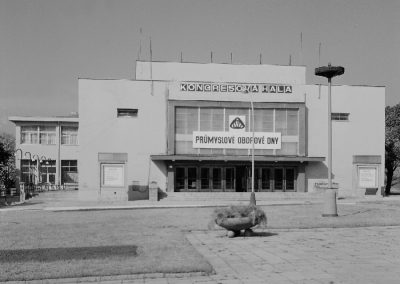History of the Theatre at the Exhibition Centre
The idea of building an Exhibition Centre in Brno originated before World War I and was finally realised in 1928. The Exhibition Centre opened with the Exhibition of Contemporary Culture in Czechoslovakia, which was an attraction of the celebrations of the Czechoslovak Republic’s tenth anniversary. The construction of a theatre and concert hall or a cinema with a café was already contemplated during the exhibition preparations.
The theatre building, which holds more than seven hundred spectators and features a café and an open terrace on the side was built to the design of architect Emil Králík, who was also the manager of the Exhibition Centre construction. During the Exhibition of Contemporary Culture, educational films were screened in the theatre during the day and theatrical performances were held in the evening. Following the exhibition and the beginning of the Exhibition Centre’s regular operations, the theatre was used by the Studio of the National Theatre in Brno, established in 1929 and run by E. F. Burian. He staged only a few productions there, introducing avant-garde theatre, which was not very pronounced in Brno at that time. However, due to the generally poor accessibility of the building, the studio soon moved to a more strategic location, the so-called Hus Assembly. The Theatre at the Exhibition Centre witnessed the end of its glory days with the era of the so-called Academic Stage, headed by Josef Bezdíček and František Kožík, among others. The Academic Stage, based on principles and methods stylistically similar to the Liberated Theatre, invited the Voskovec and Werich duo to the Theatre at the Exhibition Centre as guest artists and later on for more regular touring performances. It was there that Voskovec and Werich, together with Jaroslav Ježek, composed their famous song Tmavomodrý svět (Dark Blue World). It was also from the theatre that the Brno radio studio broadcast a live transmission of the Brno performance of Voskovec’s and Werich’s Ostrov Dynamit (The Dynamite Island).
In the interwar period, the building was not used as a theatre on a long-term basis; it served more as a cinema, concert hall, or as a short-term subsidiary stage of the Provincial Theatre. German films were shown there during the Protectorate, and at the end of the war the building was damaged by bombing. Only after the war did the theatre began to serve its original purpose more systematically –briefly housing the so-called Free Theatre, then the ensemble of the Municipal Youth Theatre, which was renamed Julius Fučík Theatre in 1948 (it existed until 1964). The building underwent a reconstruction in the 1950s, in the course of which the terrace of the café and staircase, open until then, were walled up. The theatre went out of regular use in the 1960s, used during trade fairs as a congress hall or cinema and hall for music productions. In the 1970s, the Theatre at the Exhibition Centre was used during the reconstruction of Mahen Theatre, and trade fair fashion shows were held there in the 1980s. The theatre housed a crop exchange in the 1990s; and the building has been closed since the termination of that activity in 1998. The idea of a reconstruction emerged at the beginning of the millennium, but was delayed first by the economic crisis and then by negotiations regarding the owner of the trade fair company. When the company BVV Trade Fairs Brno was taken over by the City of Brno in 2016, the theatre was finally back in the spotlight; in 2018, it was opened temporarily during the Re:publika Festival as part of the centennial celebrations of Czechoslovakia. Unfortunately, the building’s disrepair prevented its permanent use as a theatre, and that is why its reopening has taken until now.
Present Condition of the Theatre Building
Thanks to its concept and architectural design, the theatre building, designed in 1927 by architect Emil Králík, still looks modern and timeless. Over the course of many decades, the building was adapted several times, most significantly with the closing of the café terrace and a spiral staircase during a reconstruction in the early 1950s. Fortunately, most modifications after that were limited to the most urgent adaptations of the facilities, thanks to which the original spirit of the theatre building was preserved as well as a number of original details in the visitors’ area, such as the backlit ceiling made of milk glass, the main theatre hall door with its characteristic round brass windows, or a semicircular box office in the main entrance hall. Since 1991, the theatre building, together with other buildings in the exhibition grounds, have been listed in the Central List of Cultural Heritage Buildings and Monuments.
A major problem complicating the use of the theatre building today is the condition of the main hall roofing. The construction of the Exhibition Centre in 1927–28 was rushed, which negatively affected the quality of much of the construction work. Unfortunately, this includes the theatre building. After ninety years, the load-bearing concrete ceiling structure above the main hall has neared the end of its service life, and its condition no longer allows for safe operation. The theatre can therefore be used only temporarily and only to a limited extent, and the first steps in its reconstruction should be aimed at renovating the most endangered structure.
After a complete renovation, the theatre will serve as a cultural and social centre and provide space for a wide range of events. Besides film and theatre performances, congresses and conferences, lectures, public readings, social events and balls, exhibitions, concerts and festivals can take place there as well. It will provide a year-round space for permanent events and guest artists. Many events are sure to bring life to the theatre’s immediate surroundings; this will make of it a hub for the new social zone in the entrance area of the Brno Exhibition Centre.






